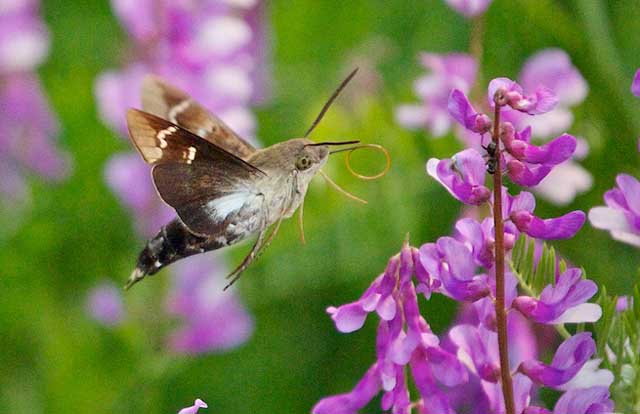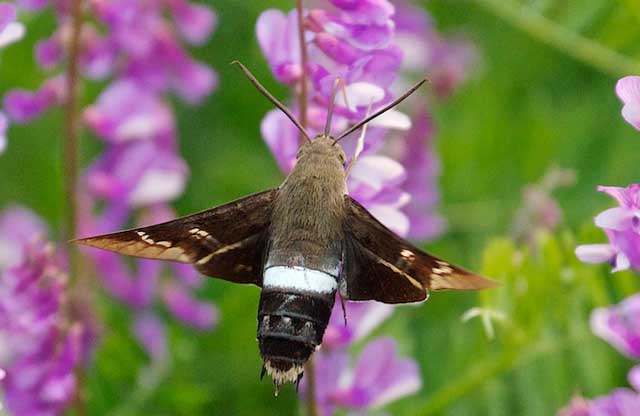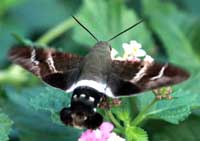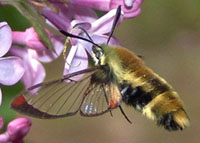|
|
Inspired by and dedicated to Jim and Bonnie Hay, (Gratiot Lake Conservancy, Mohawk, Keweenaw County, Michigan; June, 29, 2013); July 4, 2013
Updated as per James P. Tuttle's The Hawk Moths of North America; July 4, 2013
Updated as per BAMONA; July 4, 2013
|
Keweenaw County and
Houghton, Ontonagon, Gogebic, Baraga, Iron, Marquette, Dickinson, Menominee Counties
Sphingidae

Aellopos titan, Gratiot Lake Conservancy, Mohawk, Keweenaw County, Michigan,
at the Lizzadro Preserve on the shore of Lake Superior,
June, 29, 2013, courtesy of Jim Hay, via Bonnie Hay.

Aellopos titan, Gratiot Lake Conservancy, Mohawk, Keweenaw County, Michigan,
at the Lizzadro Preserve on the shore of Lake Superior,
June, 29, 2013, courtesy of Jim Hay, via Bonnie Hay.
Occasionally Aellopos titan is encountered in the northern United States in early to late fall, and such sightings are usually attributed to moths
being displaced or greatly aided in flight distances by hurricane force winds. The moth depicted above, in very good shape, is quite a surprise for so far north
so early in the summer.
Perhaps the recent tornados and strong windstorms, or extreme heat further south, have encouraged a migration or allowed for great displacement.
There is also a possibility of a pupa being unwittingly imported in soil of a purchased plant from further south.
Bonnie writes, "I am curious to know if it is breeding here, or if it has blown in as some migrating birds do who are blown off course (we are on a major spring
bird migration route)."
I (Bill Oehlke) reply, I do not think there are breeding populations north of the extreme southern US states. Wind assistance would be my first guess at an explanation.
Bonnie Hay is the Program Director of the Gratiot Lake Conservancy.
P.O. Box 310
Mohawk , MI 49950
Phone: 906-337-5476
Website: http://www.gratiotlakeconservancy.org
This page is inpsired by Jim and Bonnie Hay. Jim photographed the Aellopos titan specimen, and Bonnie notified me of the sighting and sent the images.
Forty-one Sphingidae species are listed on the BAMONA website for Michigan.
Not all of the species are reported or anticipated in Keweenaw County. (four by BAMONA as of July 4, 2013):
Lapara bombycoides, Northern pine sphinx
Hemaris diffinis, Snowberry Clearwing
Hemaris thysbe, Hummingbird Clearwing
Hyles lineata, White-lined Sphinx
I (Bill Oehlke) have added many species which I feel may be present.
It is hoped that this checklist, with the thumbnails and notes, will help you quickly identify the moths you have encountered.
A WO" after the species name indicates that I have no confirmed reports of this species in Keweenaw County, but I
(William Oehlke) expect that this moth is present.
I expect that the same species that would be found in Keweenaw County would also be found in Houghton, Ontonagon, Gogebic, Baraga, Iron,
Marquette and Dickinson Counties.
Baraga: none confirmed for Baraga;
Dickinson: Ceratomia amyntor; Pachysphinx modesta; Paonias excaecata; Paonias myops; Smerinthus cerisyi; Smerinthus jamaicensis;
Hemaris diffinis; Hemaris thysbe; Sphecodina abbottii.
Gogebic: Hemaris thysbe; Hyles lineata.
Houghton: Hemaris thysbe;
Iron: none confirmed for Iron;
Marquette: Pachysphinx modesta; Hemaris diffinis; Hemaris thysbe; Eumorpha fasciatus; Hyles lineata; Sphecodina abbottii.
Menominee: Ceratomia undulosa; Sphinx luscitiosa; Smerinthus jamaicensis; Hyles lineata.
Ontonagon: none confirmed for Ontonagon.
Please help me develop this list with improved, documented accuracy by sending sightings (species, date, location), preferably with an
image, via email to Bill Oehlke.
Please also send your sighitngs to BAMONA, an excellent online resource.
Visit Alpena County Sphingidae Larvae: Caterpillars; likely the same as would be in more northerly counties.
Visit Michigan Catocala: Underwing Moths.
Visit Sphingidae of the Americas to access similar Sphingidae lists for all US states and counties,
all Canadian provinces, Mexico, all Central and South American countries. For many of the US counties (Tompkins)
there are larvae thumbnail checklists available via the individual state files.
Sphinginae subfamily
Sphingini tribe:
 |
Ceratomia amyntor
WO/Dickinson,
the Elm Sphinx or Four-horned Sphinx
The upperside of the forewing is brown with dark brown and white
markings including a white costal area near the wing base, dark
streaks along the veins, and a white spot in the cell.
|
 |
The upperside of the forewing is pale brownish gray with wavy black
and white lines and a black-outlined white cell spot.
|
 |
The upperside of the forewing is gray with heavy black bands. The
upperside of the hindwing is brownish gray with no markings.
|
 |
Manduca quinquemaculatus
WO, the Five-spotted Hawkmoth:
This large bodied moth flies in tobacco fields and vegetable gardens
(potatoes, tomatoes) and wherever host plants are found.
|

|
Sphinx canadensis
WO,
Sphinx canadensis, the Canadian Sphinx, is not common, and is not
often reported anywhere,
but it might possibly be present in Mackinac County.Larval hosts are white ash (Fraxinus americana) and blueberry
(Vaccinium).
|
 |
Sphinx chersis
WO, the Northern Ash
Sphinx or Great Ash Sphinx: The upperside of the forewing is soft dark gray to blue-gray with
a series of black dashes, one of which reaches the wing tip.
|

|
We have them on P.E.I., but I do not see them nearly as frequently as I see the other
Sphingidae.
|
 |
The lower forewings are predominantly brownish-yellow with a fairly
wide dark bar along the inner margin. At rest the wings hug the body,
giving the moth a long slender look.
|
 |
Sphinx luscitiosa
WO/Menominee,
the Canadian Sphinx or
Clemen's Sphinx
The upperside of the forewing is yellowish gray in males and pale
gray with a faint yellow tint in females. In both sexes, the dark
border on the outer margin widens as it approaches the inner margin.
|
 |
Sphinx poecila
USGS, the Poecila Sphinx:
If you have blueberries in the woods, then you probably have the
Poecila Sphinx. They are pretty widespread throughout Michigan. |
Smerinthini Tribe:
 |
Amorpha juglandis
WO,
the Walnut Sphinx:
The adults are also highly variable; sometimes wings of an individual
may be all one color or may have several colors, ranging from pale to
dark brown, and may have a white or pink tinge.
|
 |
Pachysphinx modesta
WO/Dickinson/Marquette,
the Modest Sphinx or Poplar Sphinx:
They are a heavy bodied species.
|
 |
Paonias excaecata
WO/Dickinson, the Blinded Sphinx:
The outer margin of the forewing is quite wavy. There is a dark cell
spot and a dark oblique line mid wing from the costa almost to the
inner margin. Basic ground colour is pinkish brown. Flight would
be June-July. |
 |
Paonias myops WO/Dickinson,
the Small-eyed Sphinx:
This small species is probably widespread and common. This species
ranges across North America.
The hindwings have a small blue eyespot ringed with black on a yellow
background.
|
 |
Smerinthus cerisyi
WO/Dickinson, the Cerisyi's
Sphinx or One-eyed Sphinx:Larvae feed on poplars and willows.
Flight would be from late May-July as a single brood.
|
 |
Smerinthus jamaicensis
WO/Dickinson/Menominee, the
Twin-spotted Sphinx:
This moth is widely distributed and fairly common, and it is recorded
in Mackinac.
Along the East Coast, it flies from P.E.I. to Florida.
|
Macroglossinae subfamily
Dilophonotini Tribe:
 |
Aellopos titan
J&BH, the Titan Sphinx:
Body brown with a wide white stripe across the abdomen.
Wings are dark brown. The upperside of the hindwing has
pale patches along the costa and inner margin. stray
|
Aellopos titan, Gratiot Lake Conservancy, Mohawk, June, 29, 2013,
at the Lizzadro Preserve on the shore of Lake Superior, courtesy of Jim Hay, via Bonnie Hay.
 |
Hemaris diffinis
BAMONA/Dickinson/Marquette, the Snowberry Clearwing or Bumblebee Moth:
Flies along forest edges and in meadows, gardens,
brushy fields. Day-flying adults nectar at lantana, dwarf bush honeysuckle,
snowberry, orange hawkweed, thistles, lilac, Canada violet, etc. |
 |
Hemaris aethra
Note large orangey-brown forewing apical patch. In very similar H. diffinis patch is smaller.
On average H. aethra, compared to H. diffinis, tends to be slightly larger, with more orangey-yellow tone,
less tapering (top to bottom) of dark thorax/abdominal region; more red nr hw anal angle. possibly limited to northern Michigan.
|
 |
Hemaris gracilis
WO, The Slender Clearwing or Graceful
Clearwing:
This day flier is not commonly reported. |
 |
Hemaris thysbe
BAMONA/Dickinson/Gogebic/Houghton/
Marquette, the Hummingbird Clearwing
They are widely distributed in the east from P.E.I. to Florida. |
 |
Eumorpha fasciatus
Marquette, the Banded Sphinx
The upperside of the moth is dark pinkish brown. Each forewing has a
lighter brown band along the costa, and sharp pinkish white bands and
streaks. Larvae feed upon primrose-willow, Ludwigia (water primrose)
and other plants in the evening primrose family. Probably only occurs as a rare stray from further south.
|
Macroglossini Tribe:
 |
Amphion floridensis
WO, the Nessus Sphinix:
This day flier is widely distributed. If you have Virginia Creeper,
you probably have the Nessus Sphinx. Two bright, distinct, narrow
yellow bands are often visible on the abdomen.
|
 |
They are common in New Jersey and common
here on Prince Edward Island.
You will often see this species listed as Darapsa pholus,
especially in older literature. |
 |
Darapsa myron
WO, the Virginia Creeper Sphinx or the
Grapevine Sphinx:
It is widely reported in southern Michigan and in southern Ontario.
If you have the foodplants indicated in the common names, you probably have this
species nearby. |
 |
Hyles gallii
WO, the Bedstraw Hawk Moth
or Gallium Sphinx:
This species is reported in Mackinac, and it has been recorded in
Michigan counties north and south.
Some years I see them on P.E.I., some years, I do not.
|
 |
Hyles lineata BAMONA/Gogebic/Marquette/Menominee,
the White-lined Sphinx:
Adults usually fly at dusk, during the night, and at dawn, but they
also fly during the day over a wide variety of open habitats
including deserts, suburbs, and gardens. |
 |
Sphecodina abbottii; Dickinson/Marquette;
the Abbott's Sphinx
This moth is very much under reported on USGS. It is a
rapid day flier so is probably not in too many collections.
Grape is a popular larval host.
|
|
|
Enjoy some of nature's wonderments, giant silk moth cocoons.
These cocoons are for sale winter and fall. Beautiful Saturniidae moths will emerge the following spring and summer.
Read Actias luna rearing article.
Additional online help available.
Eggs of many North American species are offered during the spring and summer. Occasionally
summer Actias luna and summer Antheraea polyphemus cocoons are available. Shipping to US destinations is done
from with in the US.
Use your browser "Back" button to return to the previous page.
This page is brought to you by
Bill Oehlke and the
WLSS. Pages are on space rented from Bizland. If you would like
to become a "Patron of the Sphingidae Site", contact Bill.
Please send sightings/images to Bill. I will do my best to respond to
requests for identification help.
 | 
Show appreciation for this site by clicking on flashing butterfly to the left.
The link will take you to a page with links to many insect sites. |
This website has been created and is maintained by Bill Oehlke without government or institutional financial assistance. All expenses, ie., text reference
support material, webspace rental from Bizland, computer repairs/replacements, backups systems, software for image adjustments (Adobe Photoshop; L-View),
ftp software, anti-virus protection, scanner, etc. are my own.
I very much appreciate all the many images that have been sent to me, or of which I have been granted permission to copy and post from other websites.
All images on this site remain the property of respective photographers.
If you would like to contribute to the maintenance of this website by sending a contribution to
Bill Oehlke
Box 476
155 Peardon Road
Montague, Prince Edward Island, C0A1R0
Canada
your donation would be much appreciated and would be used for
1) paying for webspace rental;
2) paying for computer maintenance and software upgrades;
3) purchases of additional text reference material (journals and books) in anticipation of expanding the site to a worldwide Sphingidae site;
Anything left over going to humanitarian aid.
If you are mailing a check from USA, please use $1.25 postage (2018 rate). Donations can also be made through Paypal via the button below.































